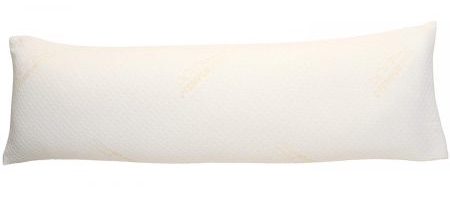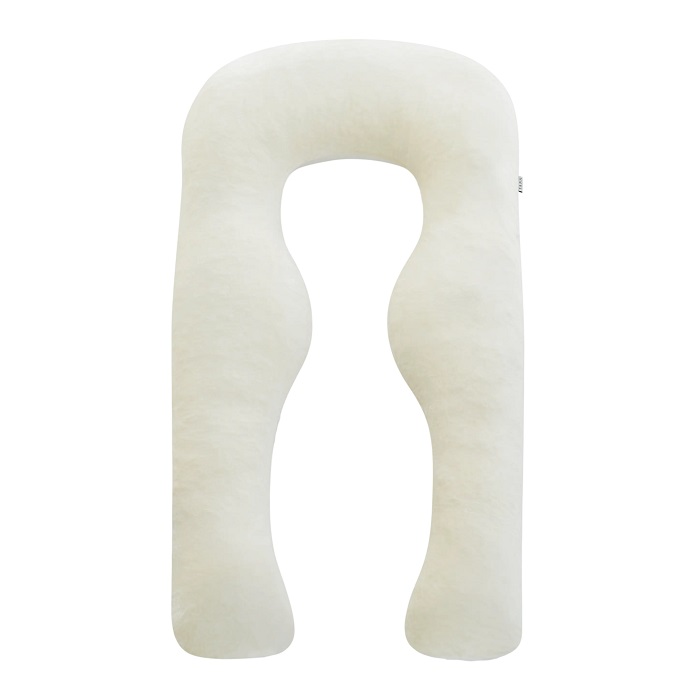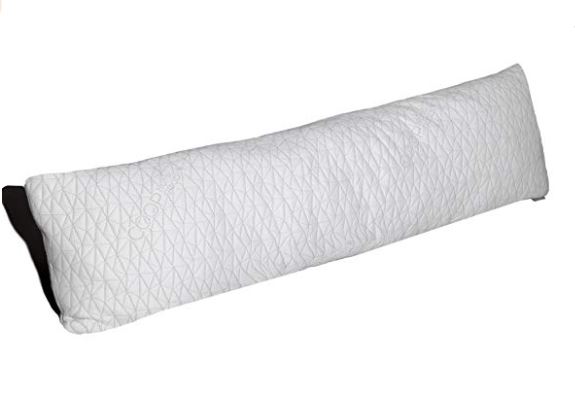Buying Guide – Shopping for the Best Body Pillow
Unlike other pillows that rest beneath the sleeper’s head and neck, body pillows are exceptionally wide and cut to measure the length of an adult’s body. Their unusual shape provides enhanced support to different areas of the body. As a result, they are popular with side and stomach sleepers, pregnant women, and people with back pain.
This guide will look at common designs and measurements for body pillows, who usually feels most comfortable sleeping with them, some tips for first-time buyers, and our picks for the best body pillows sold today.
Common Designs and Features of Body Pillows
Most body pillows measure between 48 and 54 inches wide, though they are available in a different measurements to accommodate sleepers with different heights. Body pillows generally measure 20 inches long, although this may also vary; body pillows sold today measure anywhere from less than 10 inches to more than 30 inches long. In terms of weight, body pillows generally weigh between five and seven pounds, though some weigh up to 10 pounds.
Body pillows also vary in terms of shape. Some are essentially oversized pillows with the same straight, rectangular shape as smaller sizes. Others come in curved C-, U-, or J-shaped designs. These models are designed to provide enhanced support to the neck and spine. Some may also be contoured to provide more targeted cushioning.
Body pillows may be made from different materials. Common fills include solid or shredded foam, latex, feathers, and down. The cover material also varies to a degree, but most body pillow covers are made from cotton or synthetic fabrics like polyester and/or rayon.
In addition to use during sleep, body pillows are wide enough to serve as comfortable headrests or backrests for people who like to read or watch TV in bed. Additionally, dakimakura pillows (which originated in Japan) have become somewhat popular in the U.S. and other parts of the world. These pillows are similar to Western body pillows in terms of size and shape, and often feature prints, designs, or illustrations.
Who Should Use a Body Pillow?
Body pillows provide enhanced support throughout the entire body. They help straighten the spine, prevent the pelvis from tilting forward, and take pressure off of the shoulders and hips. Although preferences vary from sleeper to sleeper, body pillows are most suitable for the following people:
- Side sleepers: Side sleeping is considered the healthiest sleep position. However, side sleepers often experience pressure and discomfort in the shoulder and arm that rests on the mattress. Snuggling with a body pillow can decrease this pressure to a significant degree. Many side sleepers also feel comfortable with the bottom of the pillow tucked between their knees, as this helps keep the pelvis aligned with the spine. It also prevents ankles from rubbing against each other, which can cause chafing and bruising.
- Stomach sleepers: While this position is not recommended due to the above-average pain and pressure potential, many stomach sleepers eliminate discomfort by sleeping with a body pillow because it allows them to rest on a soft surface without straining their neck. Some prefer a compromise position between stomach and side sleeping with their body turned slightly and the pillows resting beneath them.
- Pregnant women: As their bellies expand, many pregnant women find that sleeping on their back leads to discomfort due to the high concentration of weight in their midsection. Side sleeping can reduce this discomfort because it cradles the extra weight, and sleeping with a body pillow tucked between the knees can provide extra support for pregnant women. Body pillows can also make pregnant women feel more comfortable when resting against their backs or tucked between their legs and ankles.
- People with back pain: Because body pillows offer enhanced neck and spinal support, they can be advantageous for people with injuries or medical conditions that lead to back pain. Body pillows also alleviate bodily strain, which helps the muscles relax.
- Couples: Most body pillows are wide enough to provide cushioning for more than one person. When placed widthwise across a mattress, two people can enjoy sleeping on a body pillow — particularly if they sleep close to one another.
Back sleepers generally do not feel comfortable lying on top of body pillows because they will provide uneven support unless the pillow is extremely long. This can lead to aches and pains throughout the body. Back sleepers may feel comfortable with the body pillow turned widthwise, but smaller pillow sizes — such as Standard, Queen, and King sizes — may be just as suitable.
Important Considerations for Body Pillow Shoppers
When shopping for a new body pillow and comparing different brands and models, here are a few important factors to take into account:
- What is your body pillow budget? Body pillows are generally more expensive than smaller-size models to account for the extra width and fill. Some models cost $100 or more, but shoppers can easily find models in the $20 to $50 price range.
- How tall are you? Use your height as a guide for choosing a body pillow. While most measure 48 to 54 inches (or four to four and a half feet) wide, these will be suitable for most adults who tuck the pillow between their knees but do not require a barrier between their ankles. Longer models may be more suitable for people with above-average heights, as well as those who like a pillow between their ankles. Testing out pillows of different widths can be an effective method of choosing the right measurements.
- How heavy is the pillow? Most body pillows are fairly lightweight, but heavier models can cause pain and discomfort for side sleepers who snuggle with their pillow and sleep with one arm/shoulder beneath it.
- What fill material do you prefer? Pillows filled with materials like latex memory foam, and feathers/down tend to provide better support and feel more comfortable than those filled with synthetic materials like polyester or down alternative. However, latex, foam, and feather/down models are usually more expensive.
- Do you sleep hot? People who sleep hot or warm may feel more comfortable with pillows made from shredded foam, feathers, and other fill materials that promote air circulation inside the pillow. The cover material is also important, as natural fibers like cotton tend to be cooler and more breathable than synthetic fabrics like polyester and rayon.
- Are you pregnant? Pregnant women often feel more comfortable on longer body pillows because they can tuck them between their legs and feel the pillow against their back.
- Do you experience back pain? Longer body pillows with irregular shapes, such as C-, U-, and J-shaped models, may be the best option for people who require extra support in their back.
- Does the pillow come with a sleep trial? Many manufacturers allow purchasers to test out the pillow and, if they are dissatisfied, return the product for a full refund before the trial period ends. Sleep trials can be beneficial for body pillow shoppers who are unsure of their preferred measurements or material composition.
- How long does the product warranty last? Most pillow warranties cover product defects for five years or less – though some are longer, while other pillows do not come with any sort of warranty. However, these defects normally do not include problems that arise due to changes in the owner’s comfort preferences. If a warrantable defect does occur, warranties allow owners to replace or repair their pillow at little to no cost – so longer warranties are always the better option.





